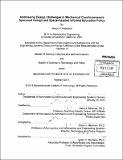Addressing design challenges in mechanical counterpressure spacesuit design and space-inspired informal education policy
Author(s)
Anderson, Allison P. (Allison Paige)
DownloadFull printable version (16.09Mb)
Alternative title
Addressing design challenges in mechanical counter pressure spacesuit design and space-inspired informal education policy
Other Contributors
Massachusetts Institute of Technology. Technology and Policy Program.
Advisor
Dava J. Newman.
Terms of use
Metadata
Show full item recordAbstract
Extravehicular activity (EVA), or spacewalks allows astronauts to accomplish some of the most important endeavors in space history. The importance of EVA will continue to increase as people venture further into our solar system. The spacesuit, used to protect the astronaut during EVA, is an anthropomorphic spacecraft that provides the physical environment a person needs to survive in the harsh environment of space. Although the suits are safe and effective, the pressurized suit becomes rigid in the vacuum of space, causing the astronaut to waste energy. Mechanical counterpressure (MCP) suits offer an alternative to gas pressurized suits by using elastic garments to provide pressure against the skin. Despite their many advantages, MCP suits are very difficult to put on, or don, making them infeasible for use today. A network of gas pressurized tubes is proposed as a solution to the donning problem. When pressurized, the tubes expand to become rigid, opening the MCP garment in the process. The system was modeled and a functional prototype was developed using a novel construction process. The model can be used as a design tool for future designs and the prototype serves as a proof-of-concept for this solution to the donning problem. The spectacular feats accomplish through spacewalks and space exploration inspire students to pursue an interest and career in science, technology, engineering, and math (STEM). Since its inception, the National Aeronautics and Space Administration (NASA) has been dedicated to educating the public about its compelling mission, fascinating discoveries, and the complicated technologies it develops. However, as the United States slips in indicators of student performance in STEM subjects, many look toward informal education, or education that occurs outside the classroom, to spur interest in STEM subjects. To maximize educational outcomes, NASA has developed a strategic framework to guide its educational programs. This framework is analyzed in the context of strategic management literature and suggests that the framework could be more easily implemented if NASA were to refine its education structure using the strengths of each of its directorates. The proposed framework was implemented in an informal education project and evaluated to determine if a projects implemented under the framework achieves the intended learning objectives. Students showed an increased understanding of NASA's mission and the complicated nature of space exploration. Suggestions to improve future projects are also given.
Description
Thesis (S.M.)--Massachusetts Institute of Technology, Dept. of Aeronautics and Astronautics; and, (S.M. in Technology and Policy)--Massachusetts Institute of Technology, Engineering Systems Division, Technology and Policy Program, 2011. Cataloged from PDF version of thesis. Includes bibliographical references (p. 155-161).
Date issued
2011Department
Massachusetts Institute of Technology. Department of Aeronautics and Astronautics; Massachusetts Institute of Technology. Engineering Systems Division; Technology and Policy ProgramPublisher
Massachusetts Institute of Technology
Keywords
Aeronautics and Astronautics., Engineering Systems Division., Technology and Policy Program.